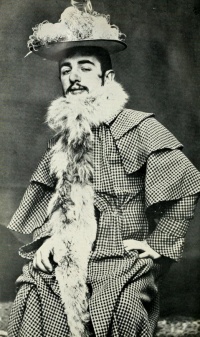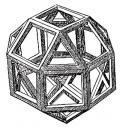Femininity
From The Art and Popular Culture Encyclopedia
|
"Femaleness [...] is primitive and archaic, while femininity is social and aesthetic."--"Speed and space: Byron" in Sexual Personae (1990) by Camille Paglia |

Illustration: Toulouse-Lautrec wearing Jane Avril's Feathered Hat and Boa (ca. 1892), photo Maurice Guibert.
|
Related e |
|
Featured: |
Femininity refers to qualities and behaviors judged by a particular culture to be ideally associated with or especially appropriate to women and girls. Distinct from femaleness, which is a biological and physiological classification concerned with the reproductive system, femininity principally refers to socially acquired traits and secondary sex characteristics. In Western culture femininity has traditionally included features such as gentleness, patience and kindness.
Contents |
Feminine attributes
These are often associated with life-giving and nurturing qualities of motherhood, birth, intuition, creativity, life-death-rebirth and biological life cycle.
The feminine archetype in mythology and world religion, is associated with a natural creative force that has a feminine or maternal function such as Mother Nature, Mother Earth, Great Mother, Great Goddess, and Mitochondrial Eve.
- In Carl Jung's school of analytical psychology, the concept of anima represents the famale half of anima and animus.
- In Chinese philosophy, the concept of yin represents the female half of yin and yang.
Feminine archetypes
Feminine archetypes are patterns of womanhood and feminine behavior that are characteristic of the human condition. They follow the biological life cycle of the woman and fall into the following roles:
- The Virgin
- The Enchantress
- The Mother
- The Warrior
- The Hag
Cultural norms
Cultural standards vary a great deal on what is considered feminine.
Cleavage
Larger breast size, a trait considered feminine, is suggested by visual clues, such as the cleavage between the breasts. Many women in western culture will emphasize cleavage to enhance femininity. They may do so by means of the cut of the outer wear, and by brassieres (bras) that push the breasts upwards and together. Special pads and inserts in the bra can also be used to aid in the higher positioning of the breasts. Also by surgical augmentation in which the breasts are lifted up and moved closer together.
Corsets
Throughout history, women (and sometimes men) of many cultures have worn corsets for support and fashion. Contrary to popular belief, historically corsets did not inhibit breath, movement, change skeletal structure significantly, or permanently displace organs. "Tight lacing" was impractical and looked down upon, and therefore it was only practiced by the smallest segment of society.
Foot binding
For centuries in Imperial China, foot binding, a practice intended to produce smaller feet, which were considered more feminine, produced unnaturally small and deformed feet, where toes often rotted due to lack of circulation.
High heels
Modern women often wear high-heeled shoes. The discomfort commonly associated with high-heeled shoes is endured for the visual effect of elongated legs.
Modest dress
In the Muslim world, women wear a hijab, indicating modesty in feminine dress. Most Islamic legal systems define this type of modest dressing as covering everything except the face and hands in public. A burqa is an outer garment worn over regular clothing when a woman goes out in public and visible to men who are not their husbands, fathers, brothers, uncles, sons and grandsons.
Neck rings
In parts of Africa and Asia, neck rings still signify femininity.
Femininity in men
Femininity in men, as masculinity in women, is often considered to be negative due to its contradiction of traditional gender roles.
See also
- Feminine psychology
- Feminization (sociology)
- Gender studies
- Marianismo
- Mitochondrial Eve
- Nature versus nurture
- Sociology of gender
- The Feminine Mystique


